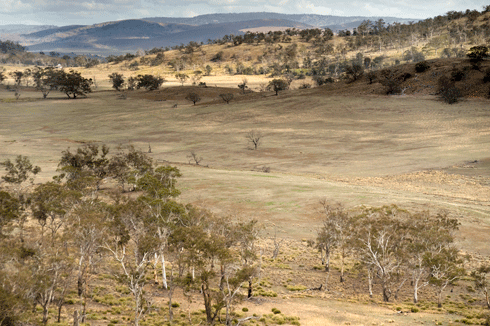
|
Published: 12 June 2013
Tassie farmers sign up to new conservation initiative
A new $3.3 million conservation fund that aims to conserve biodiversity on farms in the Tasmanian Midlands has been launched at ‘Beaufront’ in Ross – one of ten properties now signed up to the fund.

|
|
The Midlands is mostly privately owned farmland where remaining native grasslands and woodlands need to be protected. Credit:
Matt Newton
|
The fund offers farmers new stewardship agreements to pay for long-term conservation management on their land in a region that is one of Australia’s 15 biodiversity hotspots.
A partnership between Bush Heritage Australia and the Tasmanian Land Conservancy, the fund will help farmers safeguard the last pieces of remnant native grasslands and grassy woodlands without the need to acquire land. With 95 per cent of the Tasmanian Midlands being privately owned, this new approach to conservation is particularly appropriate.
Work has begun with ten Midlands landowners situated between Epping Forest and Tunbridge in the Northern Midlands. The fund will have the capacity to support many more landowners to conserve habitat on working farms as it proceeds towards a $10 million capital target by 2020.
Landowners who take up stewardship agreements are paid an annual fee for putting an agreed portion of their land under conservation management and meeting conservation targets. The initial term of an agreement is for 10 years with a goal to continuously roll over the agreement on a five year basis after that.
‘What makes this new stewardship agreement model more viable for farmers than traditional conservation covenants is that it is underpinned by a fund that can provide money for conservation in perpetuity,’ says Andy Myer, MCF Chairman and Bush Heritage Australia vice-president.
The landowners also receive conservation management resources, including ecological monitoring support to ensure the farm-based conservation programs are well supported.
‘This is an important working landscape which needed a fund that works for landowners. In order to protect the last pieces of remnant native grasslands and grassy woodlands left in this important biodiversity hotspot, lasting conservation outcomes need to be balanced alongside livelihoods, and the MCF delivers on both fronts,’ says Jane Hutchinson, Tasmanian Land Conservancy CEO.
Landowner Julian von Bibra, who is conserving 190 hectares of endangered grasslands on his farm in the Northern Midlands under the fund, says: ‘The MCF means that we now have a model that is committed to conservation and farmers working together for shared goals. Essentially, conservation now has a place on the balance sheet.’
The MCF is part of a broader ‘Midlandscapes’ project, which has a goal of ensuring ten per cent (or 64 000 hectares) of the Tasmanian Midlands Biodiversity Hotspot is conserved by 2020.
Native species protection priorities include vulnerable marsupials such as the Tasmanian bettong (a species extinct on the mainland) and spotted-tailed quoll; wedge-tailed eagles; critically endangered lowland grasslands; and nationally threatened plants such as the pungent leek-orchid.
Around 92 per cent of land in Australia's 15 biodiversity hotspots is privately owned. That means 180 million hectares of land in Australia's biodiversity hotspots remains unprotected by our National Reserve System, making innovative private conservation partnerships especially critical.
Source: Bush Heritage Australia



